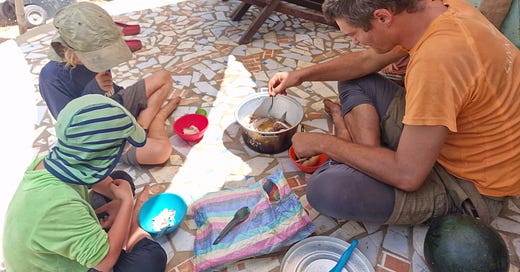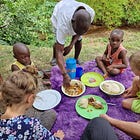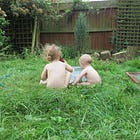Chew on this: Pros and cons of traditional approaches to weaning
Baby-led, spoon-fed, or something else?
As the rain cascaded down the palm-frond roof, it picked up the morning’s offerings of dead leaves, fallen fruit, and resting insects and threw them to the ground. Stunned beetles did their best to climb out of rapids that were forming across the forest floor, and the frogs held tight to their leaves but didn’t hide. They needed to be ready to claim the wetter half of the day for amphibian kind.
Despite the rain bringing slightly cooler temperatures, I was sweating more than ever. My friend was visiting and kindly brought some fish boilie. My friend has an Amerindian tolerance for chilli. A droplet rolled down my nose and dripped off.
Though powerfully spicy, the fish boilie was very tasty, and had been prepared in the traditional way. Bones and all. I mumbled the fish around in my mouth, feeling for the bones, and taking out the biggest ones with my fingers. The tiny, bendy, scratch ones, I just chewed up. Every delicious mouthful was an exercise in patience.
For me, eating fish like this took a lot of attention, but my Amazonian friend did it without thinking. She didn't even pause speaking, just flicking bones out between words with her tongue like punctuation. I couldn't help but be impressed.
At the same time, my children were watching her daughter and baby son, just as transfixed as I was. There was something magical going on.
The young girl was just as skilled a bone sorter as her mother but she was doing something else too. The moment we'd all started eating, her little brother had started reaching for her mouth, burbling with excitement. And now, in response, occasionally, in between eating mouthfuls herself, she was deftly depositing a chewed-up fish cake on her fingertips and popping it into the happy infant. His excited face would suddenly become solemn for the serious business of eating, and then a laborious minute later, the grin would return and the reaching would resume.
Watching this, my eldest daughter's face slowly lit up. She looked at her plate of fish. She looked at her own baby sister. And she started chewing with purpose.
Babies need solid food before they have the apparatus to eat it
Compared to those of other mammals, even human babies that aren't WEIRD (Western, Educated, Industrialised, Rich, and Democratic) are weird! Unlike everyone else in the family tree, we have a long gap between the moment when we start needing nutrition from food (in addition to just milk) and when we eventually grow the teeth required to eat it. To be specific, most babies need more than breastmilk at about six months, but they don't grow molar teeth (which are essential for eating that required food) until they're about two years old. This means that, unlike other mammals, humans have to provide our babies with transitional foods, which give them enough diversity of nutrients in a form that they can actually swallow.
As we've talked about before, moments of change are really important for the long-term structure of our life-long microbiomes, and this shift onto food is one of the biggest. The initial foods and the way they're delivered affects how our gut microbes and immune system will support each other throughout the entire life.
So, how is it that growing up WEIRD changes this moment of change, what are the effects, and what can we do about it?
What happens in traditional cultures?
Eating solid foods is a very different skill from breastfeeding or drinking milk. For babies to learn how to eat solid foods, they first need to understand how their mouths work - how to get things into them, and also, should they need to abort an eating mission, how to get things out before they choke. These important skills require training.
Whether we recognised it or not, we've all watched this training happening. We make jokes about it. From a very early age, babies put their hands (and any nearby object that isn't nailed down) into their mouth. They feel them. They move them about with their tongue. When they feel like it, they spit them out. Then, from about four months, many babies start to be very interested in food, and, if given a holdable piece of food, will start to put it towards their mouth. Babies will often put items in and take them out many times as they practise.
They then move on to practising removing pieces from the mouth and throat to protect their airway. Again, all parents have seen this: during early meals the majority of food is taken into the mouth, moved to the back of the tongue, and then ejected with great speed and, often, laughter.
Only once they have mastered the ins and outs, can babies move on to the more subtle processes of chewing, sorting, and swallowing food. This part, as anyone who has recently bitten their cheek can confirm, takes a lifetime to perfect.
But the baby's body doesn't just need to learn the mechanics of processing food, it also needs to host and encourage the right microbes. The milk-fed microbiome is no longer fit for purpose, so it must be overhauled by feeding a diverse range of new foods.
In effect, the earliest foods are half to feed the baby and half to feed the microbiome, and so need to contain nutrients (protein, fat, etc.) for the baby and nutrients (complex carbohydrates, fibre, etc.) for the microbes.
In addition to the right nutrients, many cultures’ first foods contain beneficial microbes themselves - some because of fermentation and some because of how the food is prepared. I'm about to go into detail about one of those preparation methods that some people find a little…gross. Deep breath.
Babies elsewhere are fed pre-chewed food
It surprised me to learn that in every society (that has been investigated) around the world, babies were historically (or are still) given food that has first been chewed for them and then spat out. Fittingly, the name for this practice is a bit of a mouthful - premastication.
As well as allowing the parent/carer to check for temperature and spoilage (and small bones), premastication softens and lubricates food making it easier for the baby to swallow. Premasticated food is fed, depending on the culture, from the hand, from a spoon, or mouth-to-mouth.
Making use of the parent's food processing equipment in this way means that babies can join in with meals from an early age, can eat a wide range of different foods, and can experience foods with different particle sizes, shapes, and textures. It also frees parents from needing to prepare or carry baby-specific foods.
Finally, as I alluded to earlier, chewing food around in the parent's mouth loads it with enzymes (mostly salivary amylase) and mouth bacteria, which help digest the food better and, again, support the developing microbiome.
So, globally, premastication is a big deal. I've seen it practised on three continents. But it's so uncommon in WEIRD cultures that many of you reading will be pretty disgusted by this new idea. Why?
Pre-chewing food fell out of fashion in WEIRD cultures
With the advent of food processors, parents could make extremely soft puréed foods. As breastfeeding fell out of favour, puréed foods were desirable because they could be spooned into infants who had not yet learned how to move food out of their mouths, without risking them choking. At this point, an industry arose to supply pre-prepared puréed baby foods and (as often happens when things get a massive marketing budget) societal acceptance of free competitors disappeared. Premastication became a behaviour of the poor, shameful amongst the upper classes, and eventually, thanks to the march of technological progress making cheaper kitchen gadgets, avoidable for all! Huzzah!
Worse still, we then started to project our prejudices on the rest of the world. The evidence around premastication is mixed. For example, studies have proven that the practice both passes on the bacteria associated with tooth decay and reduces the actual resulting tooth decay. Also, it should be noted that premastication may be able to transmit cold sores, Helicobacter pylori (a bacterium which in some people causes gastric ulcers and may increase the risk of gastric cancer (although, interestingly, the risk of it doing so is much lower in traditional cultures and nobody yet knows why)), and, if there are mouth wounds, HIV.
On the other hand, the body appears to have systems to decrease the risk of disease transmission via the mouth. Compounds in adult saliva reduce the risk of HIV transmission from premastication to lower than that of breastfeeding (a practice which is recommended for HIV-positive mothers).
Tellingly, despite the cultural pressure and these risks, the World Health Organisation has refused to condemn premastication (it publishes position statements on practises that it believes damage health). And yet medical textbooks written in the West are full of ways to talk mothers out of this disgusting habit.
Current WEIRD weaning approaches don’t provide all the benefits of premastication
So, with premastication having been removed from WEIRD cultures, we did what we do and invented something new to fill the gap! Two newer approaches now mark the opposite ends of the weaning spectrum: ‘spoon-fed’ and ‘baby-led’ weaning. Very few parents do exclusively one or exclusively the other. Most UK babies are weaned with some combination of both.
Proponents can (and will) go into depth, but, in short:
Spoon-fed weaning (‘SFW’) involves spooning (or, more recently squirting from a tube attached to a foil pouch) increasingly lumpy purée into the baby's mouth until, after a long while, solid food is the next textural step.
Baby-led weaning (‘BLW’) involves providing Junior with a collection of very different food items, of which, the majority will initially be mouthed, examined, and thrown about, until, after a long while, solid food is understood well enough to be eaten.
There are pros and cons to both.
Spoon-fed weaning
Pros - Less mess.
Cons - May increase fussiness. Less learning to gag. Higher risk of wonky teeth and needing orthodontic braces later.
Baby-led weaning
Pros - Less parental work. More variety. More nutrition. Satiety learning
Cons - Might not, initially, get many calories or much iron. Also very, very frustrating for any adult watching.
And how does premastication stack up against the two newcomers? Like this:
Better training to manipulate small, hard particles in the mouth (e.g. carrot chewings). These particles are a major part of good diets and neither of the major WEIRD approaches includes them (SFW provides small, soft particles and BLW provides large, hard or soft particles).
Wider variety of flavours, important for preventing fussiness (SFW flavours are limited by product range, BLW flavours are limited by chewability. Good luck with that Brazil nut, young ’un).
Not at all frustrating.
And, as mentioned, there are the benefits conveyed by the parent's mouth itself:
Reduced risk of developing allergies (a benefit that can also delivered by other ‘gross’ saliva-swapping behaviours like sharing utensils or sucking a dropped dummy clean rather than sterilising it).
Shared growth factors for improved growth and healing.
Improved starch digestion due to adult salivary amylase.
Weakened, pre-attacked pathogens, which may help the baby's immune system to develop some immunity towards them without becoming seriously ill.
So, perhaps something to avoid if you have another option while you're sick (or unsure of your HIV status), but on the whole a great way to get the right nutrition into a baby while also reducing the lifelong risks of allergy, poor diet selection, and choking.
What should we do?
When we introduce solid foods, we’re trying to do lots of different things for babies. Get them used to different tastes, different textures, moving food around, swallowing food, eating a range of foods, etc. But there are a few key principles that can help.
Give the baby nutritious, minimally processed foods that the adults around them are eating too. This will help them get used to the parents’ (hopefully quite healthy) diet, it will encourage them to model eating behaviours, and the foods are likely to require them to move their mouths in lots of different ways.
If you’re not the sort to carry a pestle and mortar around with you everywhere, then pre-chew foods that the baby can’t otherwise swallow - bits of raw carrot, nuts, tough meat. If you want to go full-on primal parent, you can transfer it mouth to mouth, but most of the time it's not hard to have clean hands in a WEIRD environment. So, once I’d summed up the courage to try this, I found it less embarrassing to chew the food, discreetly put it in my hand, and then transfer it to my baby’s mouth. I managed, when stuck on an equally stuck train, to keep a hungry baby sated with nothing but an entire raw carrot without anyone noticing (or, at least, without anyone mentioning…).
Don’t throw the baby out with the bathwater when it comes to purees. Just because you’re trying to give lots of adult-style foods doesn’t mean that purees are always bad. Many adults enjoy soups, dals, and dips - if you’re eating them, let the baby have some too. According to my partner, houmous is the best baby food there is…
Introducing solid foods is an exciting time! It’s a stage where the baby takes another step into personhood. It’s the time where they form the food preferences that they’ll take with them throughout their life. And it’s much easier if, like in most of the world, they’re eating whatever goes into your mouth…
Want to hear my partner and I discuss our experiences of introducing solid food to babies? We have a podcast where we use the topic from the previous post and give context and examples to help bring it to life. There’s also a weekly news section where we dive into interesting research into child development from the previous week.
This is the sound of Sunday evenings in our house!
You may also like…
Notes
Premastication may transmit bacteria associated with decay: https://www.ncbi.nlm.nih.gov/books/NBK535349/
Premastication may reduce tooth decay: https://www.ncbi.nlm.nih.gov/pmc/articles/PMC5101600/ and https://www.fortunejournals.com/articles/parity-maternalchild-oral-interactions-and-early-childhood-caries-ecc-among-northern-nigerian-hausa-children.html
Premastication may transmit Helicobacter pylori: Taylor, D.N. and Blaser, M.J. (1991) The Epidemiology of Helicobacter pylori Infections. Epidemiology Review, 13, 42-59. (though H. pylori is a commensal and asymptomatic in most individuals, and there is enormous cultural variation in whether H. pylori increases the risk of gastric cancer or not. And it seems to reduce the risk of other diseases - https://pmc.ncbi.nlm.nih.gov/articles/PMC9667403/ )
Premastication may occasionally transmit HIV: https://pubmed.ncbi.nlm.nih.gov/19620190/
Salivary compounds reduce the risk of HIV transmission: https://pubmed.ncbi.nlm.nih.gov/16700731/
The risk of sharing premasticated food is lower than that of breastfeeding: Pelto, Gretel H., Yuanyuan Zhang, and Jean‐Pierre Habicht. "Premastication: the second arm of infant and young child feeding for health and survival?." Maternal & Child Nutrition 6.1 (2010): 4-18.
Spoon-fed weaning may increase selective eating:: https://www.sciencedirect.com/science/article/abs/pii/S0195666318305580
Babies weaned on purees may develop the gag reflex later: https://onlinelibrary.wiley.com/doi/full/10.1111/jhn.12528
Spoon-fed weaning may increase the risk of malocclusion: https://www.mdpi.com/2227-9067/11/2/201
Baby-led weaning may result in increased variety of foods eaten https://onlinelibrary.wiley.com/doi/full/10.1111/jhn.12528
Until a year or so ago, the jury was out on whether baby led weaning provided enough nutrition. However, a recent study suggested that actually babies weaned using baby-led techniques were getting more protein and were growing faster. https://cdn.nutrition.org/article/S2475-2991(24)00946-6/fulltext
Baby-led weaning may help babies to learn when they are full: https://www.mdpi.com/2072-6643/4/11/1575
Baby-led weaning may make it harder for babies to get enough calories or iron: https://ijponline.biomedcentral.com/articles/10.1186/s13052-018-0487-8
Premastication may reduce risk of developing allergies: Y. Kubo, K. Yoshizawa The negative association of pediatric allergy risk and premastication in infancy: a cross-sectional study [in Japanese] J Prevent Med, 10 (2015), pp. 19-24
Sharing utensils may reduce risk of developing allergies: https://www.sciencedirect.com/science/article/pii/S2772829323000334#bib11
Parents sucking a child’s dummy may reduce the child’s risk of developing allergies: https://publications.aap.org/pediatrics/article-abstract/131/6/e1829/31156/Pacifier-Cleaning-Practices-and-Risk-of-Allergy
Premastication may share growth factors, improve starch digestion, and provide weakened pathogens to train the immune system: https://pmc.ncbi.nlm.nih.gov/articles/PMC6860819/
Interesting study with 350 Hausa children in Nigeria a few years ago found that in that population, “Unexpectedly, the proportion of children with caries was significantly greater in children who were not fed premasticated food by their mothers (4.8% vs. 0.7%, p=0.03). https://fortuneonline.org/articles/parity-maternalchild-oral-interactions-and-early-childhood-caries-ecc-among-northern-nigerian-hausa-children.html










I prechewed food for my two youngest, and I'm not sure how it started, but boy did it make my life easier!! Less to carry on days out, less mess at the table,no need to prepare other meals. They're 2 and 4 now and have excellent teeth, robust immune systems and eat ANYTHING.
Definitely threw my in-laws family for a loop, though, who had a similar aged babe atThanksgiving dinner who was eating rice cereal while my kid had everything on my plate-- I suppose puling chewed food from your mouth IS impolite ;)
I have to admit my BLW got sloppier with each child. It’s just a god damn mess and with other children needing me I just can’t be bothered. And as to pre-mastication… I use scissors 😆 didn’t even occur to me, but I found that cut up vegetables are more palatable to kids so I did it. I also didn’t want to feel stuck making meatballs- who has time for that?? (or drumsticks/beef strips that aren’t meant to be ingested at first) if I want a very young baby to eat meat. So I take my food, cut it up, and serve.